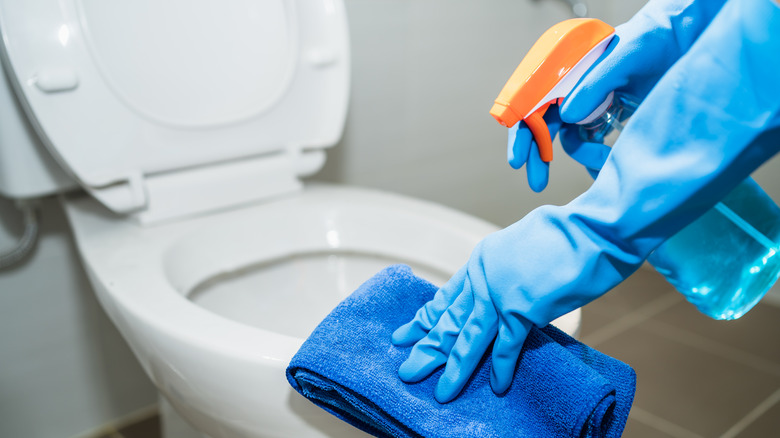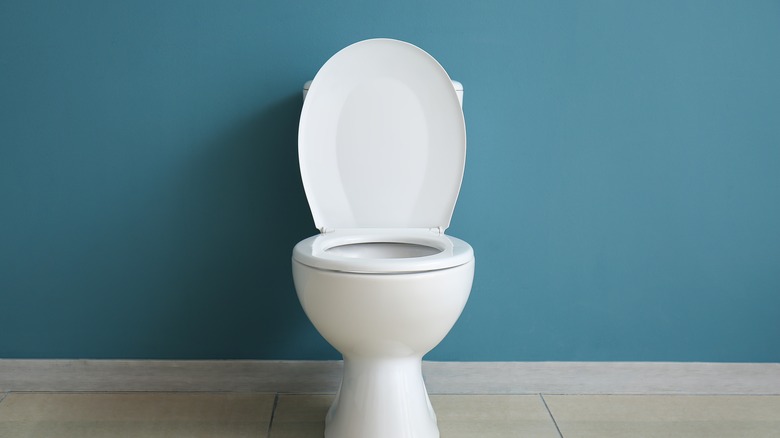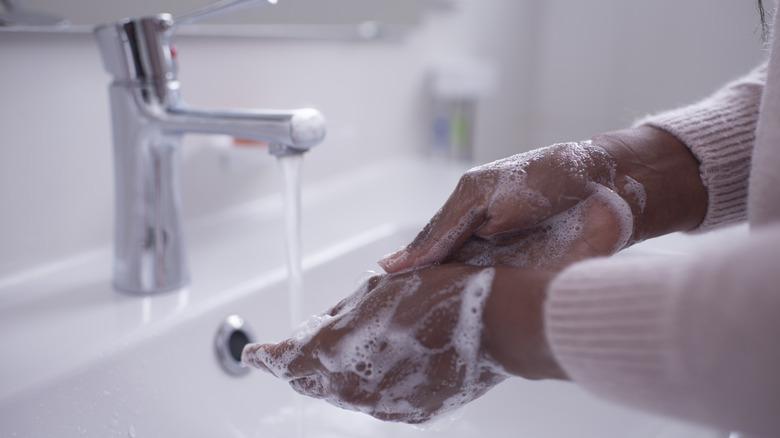The Germy Reason You Shouldn't Flush Public Toilets With Your Feet
Using a public toilet, especially when it's less than satisfactorily clean, can be nerve-racking. And if it wasn't cringey enough, the Covid-19 pandemic has only made us more wary of germy surfaces. If you're like most Americans, you'll try any and all methods before touching a flush or a toilet seat while doing your business.
But if you've been using your feet to flush the toilet (like 43% of Americans, according to a 2023 study done by Bradley Corporation), you may want to think about stopping the habit. As explained by University of Minnesota infectious disease researcher, Nidhi Ghildayal (via The Healthy), flush handles in public restrooms gather bacteria partially because people use their feet instead of their hands to flush the toilet. "The floor and the bottom of your shoes are generally some of the dirtiest parts of a bathroom," she added.
Basically, you're doing more harm than good by raising a bacteria-laden foot to a flush — especially for the people who'll be using the toilet after you. When it comes to public toilets, you should know that gut bacteria don't survive for long on cool, dry surfaces. So your line of defense for not touching a toilet flush might not be as straightforward as you think.
Gut bacteria thrive in our bodies, not outside
If your fear of gut bacteria is making you a pro at lifting your leg to flush the toilet, you might want to think twice. Yes, fecal bacteria can spread to bathroom surfaces. But according to assistant professor at the Institute for Systems Biology, Sean Gibbons (via Time), they're not as big a concern as we think. "Over the course of a day, the first thing that shows up is fecal bacteria — microbes from your gut — transmitted to the toilet seat and things like that. But those bacteria actually do poorly on those surfaces."
This is because bathroom fixtures that are exposed, dry, cool, and smooth, don't provide the right environment for bacteria to thrive in — unlike the environment inside our bodies.
Another factor — as explained by microbiology and immunology professor, Bob Hancock (per City News), you need a considerable amount of diarrhoeal pathogens in order to be in danger of an infection. "... For many diarrheal pathogens, which is what you're worried about, getting diarrhea from touching something that's been in somebody's body, you require quite a lot of bacteria in order to get an infection," he explained.
Flush with your hands, but wash them well
The most effective option is to use your hands to flush the toilet, and then wash them with soap after you leave the stall. If you're still feeling icky about using your hands, you may wonder if toilet paper might be of use. The official answer is "Not really," according to a senior biology teacher at Hutchesons' Grammar School (via The Royal Society). "It is not commonly realized that toilet paper, no matter how thick or medicated, does not act as a physical barrier to the transfer of bacteria."
Washing your hands is your best bet either way. In fact, it's never wise to assume that you can skip washing your hands after using a public restroom. Always wash your hands with soap and warm water and make sure you take your time and get into all the crevices before rinsing and drying your hands. Speaking of drying, avoid the air dryer if you can and reach for a paper towel instead. A 2018 study found that air dryers can spread bacteria collected from the air onto clean hands underneath.
The important thing to remember is that by using your feet in an effort to be clean, you're building a habit that actually spreads more germs than you realized. Be mindful of the fact that public toilets are for everyone, and try not to contribute toward germ buildup if you can help it.



